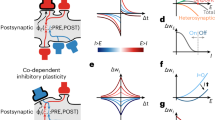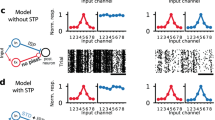Abstract
BIDIRECTIONAL control of synaptic strength is thought to be important for the development of neuronal circuits and information storage. The demonstration of homosynaptic long-term depression1 greatly enhances the usefulness of the synapse as a mnemonic device, but theoreticians have also seen the need for heterosynaptic decreases in synaptic efficacy, both in neuronal development2–4 and information storage5. Indeed, induction of long-term potentiation in one population of synapses can be associated with a modest depression at neighbouring inactive synapses in the same population of cells6–10. Here we report that in the CA1 region of the hippocampus this heterosynaptic long-term depression has the property that its sites of induction and expression occur in different populations of cells and thus requires the spread of a signal between neurons. Such a mechanism ensures a widespread distribution of this form of plasticity.
This is a preview of subscription content, access via your institution
Access options
Subscribe to this journal
Receive 51 print issues and online access
$199.00 per year
only $3.90 per issue
Buy this article
- Purchase on Springer Link
- Instant access to full article PDF
Prices may be subject to local taxes which are calculated during checkout
Similar content being viewed by others
References
Bear, M. F. & Malenka, R. C. Curr. Opin. Neurobiol. 4, 389–399 (1994).
Artola, A. & Singer, W. Trends Neurosci. 16, 480–487 (1993).
Collingridge, G. L. & Singer, W. Trends pharmac. Sci. 11, 290–296 (1990).
Stent, G. S. Proc. natn. Acad. Sci. U.S.A. 70, 997–1001 (1973).
Sejnowski, T. J. J. theor. Biol. 69, 385–389 (1977).
Linden, D. J. & Connor, J. A. A. Rev. Neurosci. 18, 319–357 (1995).
Christie, B. R., Kerr, S. & Abraham, W. C. Hippocampus 4, 127–135 (1994).
Lynch, G. S., Dunwiddie, T. & Gribkoff, V. Nature 266, 737–739 (1977).
Castro-Alamancos, M. A., Donoghue, J. P. & Connors, B. W. J. Neurosci. 15, 5324–5333 (1995).
Desmond, N. L., Colbert, C. M., Zhang, D. X. & Levy, W. B. Brain Res. 552, 93–98 (1991).
Grover, L. M. & Teyler, T. J. Neurosci. Lett. 154, 39–42 (1993).
Manzoni, O. J., Manabe, T. & Nicoll, R. A. Science 265, 2098–2101 (1994).
Wickens, J. R. & Abraham, W. C. Neurosci. Lett. 130, 128–132 (1991).
Mulkey, R. M. & Malenka, R. C. Neuron 9, 967–975 (1992).
Sah, P., Hestrin, S. & Nicoll, R. A. Science 246, 815–818 (1989).
Boulton, C. L. et al. Eur. J. Neurosci. 6, 1528–1535 (1994).
Baskys, A. & Malenka, R. C. J. Physiol., Lond. 444, 687–701 (1991).
Muller, D., Hefft, S. & Figurov, A. Neuron 14, 599–605 (1995).
Mulkey, R. M., Herron, C. E. & Malenka, R. C. Science 261, 1051–1055 (1993).
Chan, C. P., McNall, S. J., Krebs, E. G. & Fischer, E. H. Proc. natn. Acad. Sci. U.S.A. 85, 6257–6261 (1988).
Bonhoeffer, T., Staiger, V. & Aertsen, A. Proc. natn. Acad. Sci. U.S.A. 86, 8113–8117 (1989).
Schuman, E. M. & Madison, D. V. Science 263, 532–536 (1994).
Wigström, H. & Gustafsson, B. Nature 301, 603–604 (1983).
Schreurs, B. G. & Alkon, D. L. Brain Res. 631, 235–240 (1993).
Martin, K. A. C. Q. J. exp. Physiol. 73, 637–702 (1988).
Wilson, M. A. & McNaughton, B. L. Science 261, 1055–1058 (1993).
Castillo, P. E., Weisskopf, M. G. & Nicoll, R. A. Neuron 12, 261–269 (1994).
Author information
Authors and Affiliations
Rights and permissions
About this article
Cite this article
Scanziani, M., Malenka, R. & Nicoll, R. Role of intercellular interactions in heterosynaptic long-term depression. Nature 380, 446–450 (1996). https://doi.org/10.1038/380446a0
Received:
Accepted:
Issue Date:
DOI: https://doi.org/10.1038/380446a0
This article is cited by
-
Synaptic plasticity-dependent competition rule influences memory formation
Nature Communications (2021)
-
PKN1 promotes synapse maturation by inhibiting mGluR-dependent silencing through neuronal glutamate transporter activation
Communications Biology (2020)
-
The Contribution of Extrasynaptic Signaling to Cerebellar Information Processing
The Cerebellum (2014)
-
Long-Term Potentiation in Spinal Nociceptive Pathways as a Novel Target for Pain Therapy
Molecular Pain (2011)
-
Locally dynamic synaptic learning rules in pyramidal neuron dendrites
Nature (2007)
Comments
By submitting a comment you agree to abide by our Terms and Community Guidelines. If you find something abusive or that does not comply with our terms or guidelines please flag it as inappropriate.



